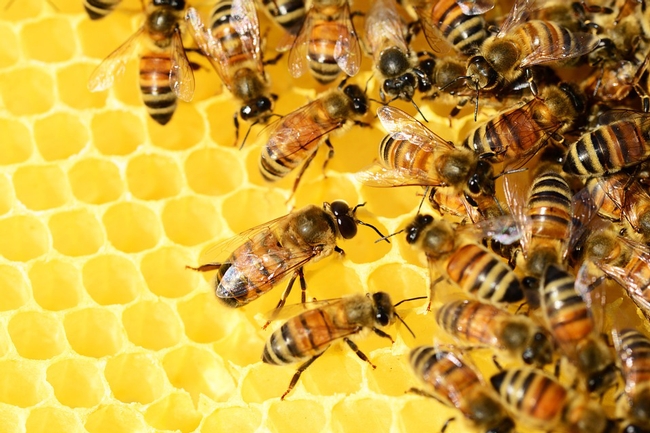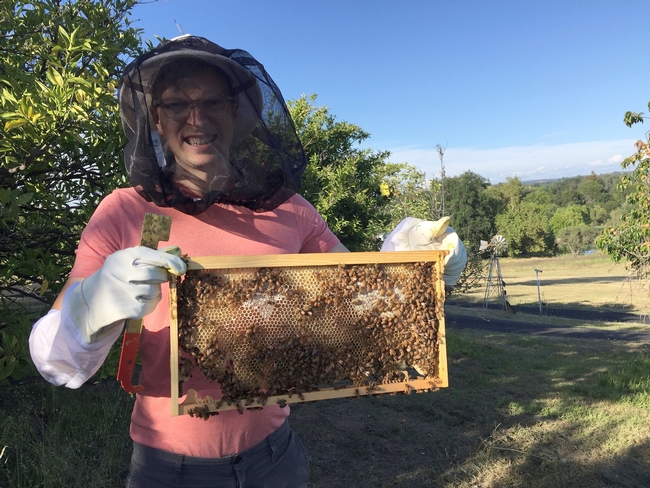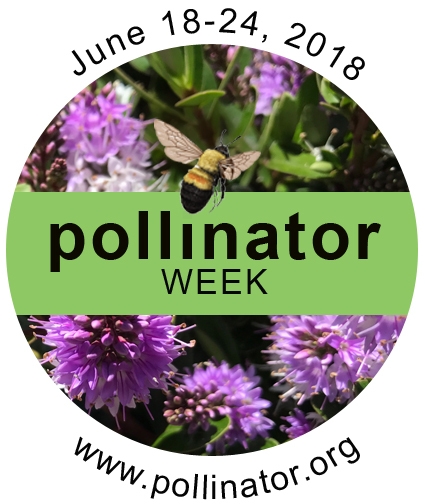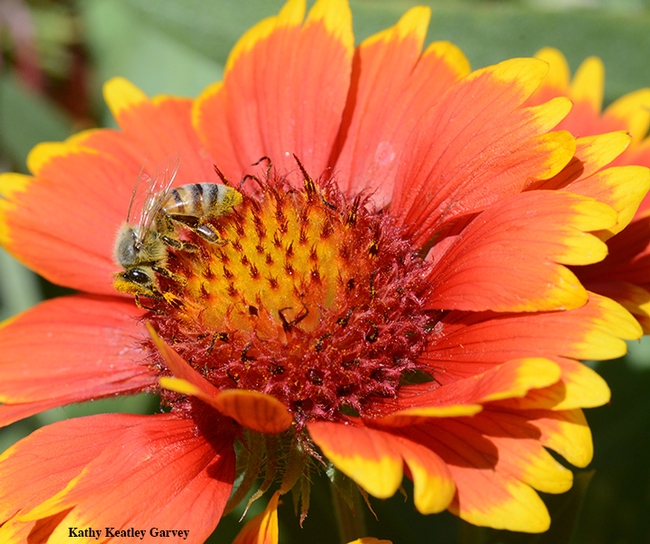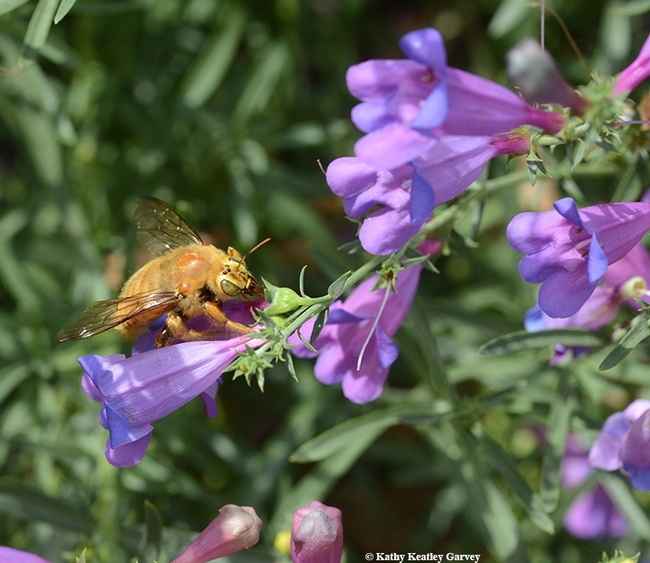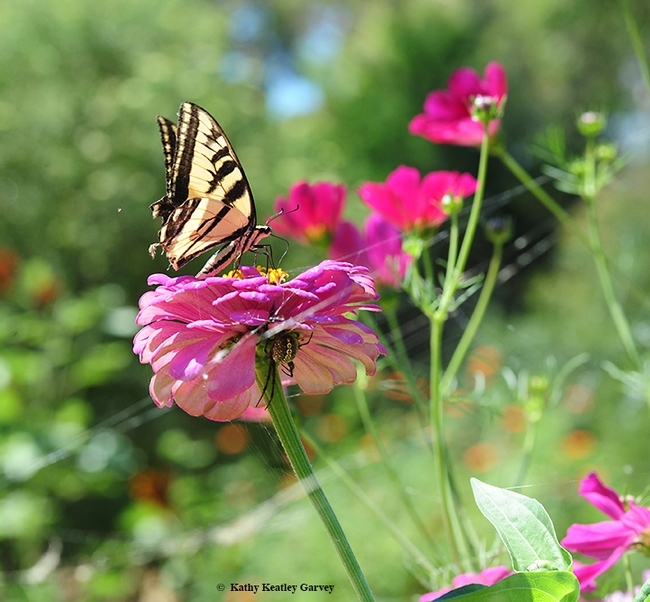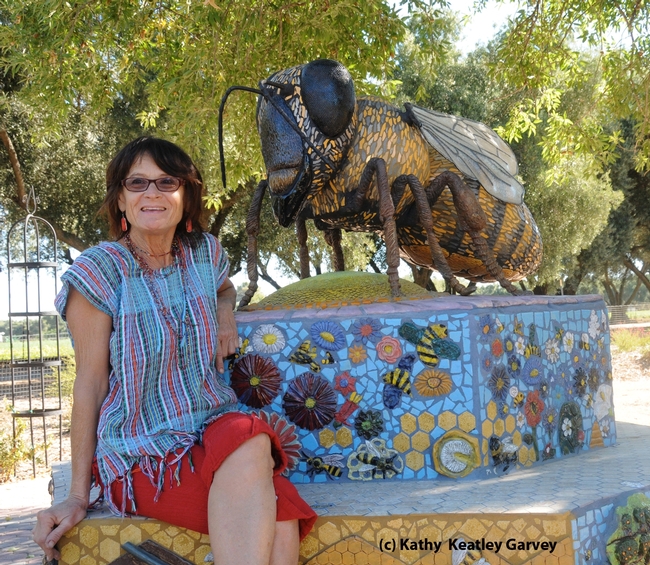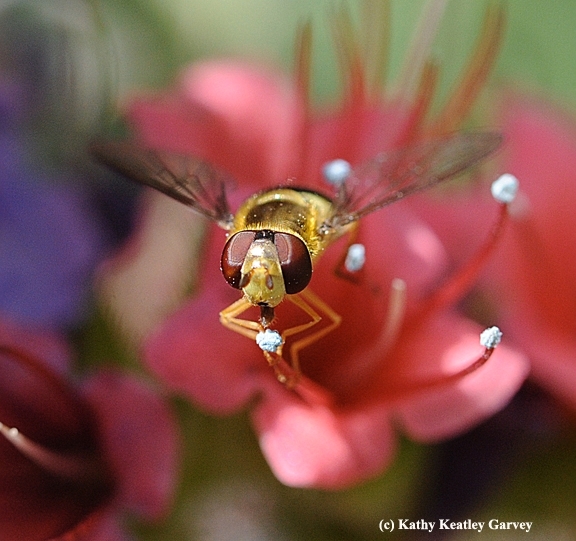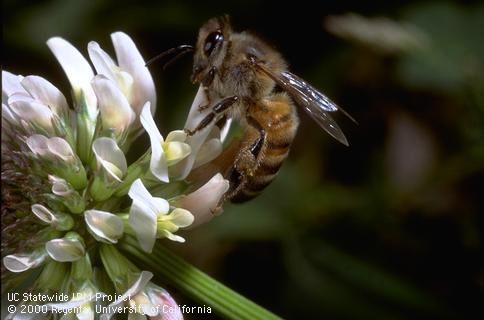Posts Tagged: honey bees
Honey bee health key to wellbeing of important species
Our friends the honey bees make it possible for us to devour an abundance of almond products. In 2016 the California almond crop totaled 2.15 billion pounds valued at $5.2 billion. Growing 80 percent of the world's almonds in California takes a lot of honey bees for pollination, roughly two hives for every acre of almond trees. It's estimated that California has 1.3 million acres of almonds, stretching 400 miles between Bakersfield and Red Bluff.
California is rated in the top five honey producing states in the nation. The U.S. per capita consumption of honey is around 1.3 pounds per year. Our buzzing friends visit millions of blossoms, making pollination of plants possible and collecting nectar to bring back to the hive. Lucky for us bees make more honey than their colony needs allowing beekeepers the opportunity to remove the excess honey and bottle it for us to enjoy.
Bees are animals too
Bees are one of our planet's most important animals. They produce honey and they are the primary managed pollinators for a majority of high value specialty crops grown in the contiguous states of California and Oregon, such as nuts, stone fruits, vegetables, and berries. A problem looms for our animal friends, the bees. Colony losses are high due to a variety of environmental and biological causes including bacterial diseases. Historically, beekeepers have self-prescribed antibiotics to control these diseases.
Enter UC Davis and Oregon State University to aid beekeepers in addressing the problem of antibiotic resistance and antimicrobial use in the feed or water of food-producing animals, namely, protecting the health and safety of bees. The overall strategy leads to a safer food supply because the potential for antibiotic resistance is reduced.
The Western Institute for Food Safety and Security (WIFSS), UC Cooperative Extension, and UC Davis School of Veterinary Medicine are partnering with Oregon State University in a USDA funded multi-state specialty crop project to develop CE training for veterinarians on bee health and antibiotic use — a practice that is now regulated under the Veterinary Feed Directive (VFD). The project will offer a comprehensive bee biology online course and train-the-trainer practical training for veterinarians and apiculture educators. The ultimate goals are to protect the specialty crop — honey — from becoming contaminated with antibiotic residues; to protect the health and safety of bees, which are essential to California agriculture; and, finally, to support veterinary oversight in the use of antibiotics, which will lead to an overall reduction of antibiotic resistant bacteria in the environment.
The $483,278 award will address the unique needs of the beekeeping industry that have been experiencing high colony losses since 2006. It will also focus on new rules established by the U.S. Food & Drug Administration on the use of antibiotics which are used to control certain diseases affecting bee colonies.
The principal investigator is Elina L. Niño, a UC Cooperative Extension specialist with the UC Davis Department of Entomology and Nematology. Project leader is Bennie Osburn, director of outreach and training at WIFSS. Collaborating in the project is Jonathan Dear, from the Department of Medicine and Epidemiology at UC Davis School of Veterinary Medicine, and the partner state collaborator is Ramesh Sagili from the Department of Horticulture at Oregon State University. A team of graphic and instructional designers from WIFSS will work with Drs. Niño, Dear, and Sagili, to translate the science into user friendly information for veterinarians and beekeepers.
Educating about honey bee health
Dear who is collaborating with WIFSS to produce an online and hands-on module to train veterinarians about beekeeping and honey bee health, points out that, “Honey bees are such an important part of our economy and, like any food producing animal, they can be affected by preventable and treatable diseases.”
He is enthusiastic about the project and says, “Our hope is that by educating veterinarians about honey bee health, they can play a key role in maintaining the health and wellbeing of this important species.”
With the efforts of extension specialists, veterinarians, and graphic and instructional designers, beekeepers and veterinarians will work together to navigate the VFD regulations, and consumers will continue to enjoy nature's sugar.
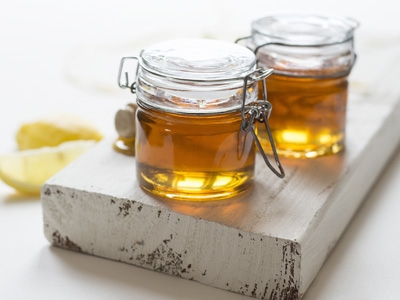
UCANR-Honey-400x300
National Pollinator Week: Open house at UC Davis Bee Garden
June 18-24 is National Pollinator Week.
Do you know where your pollinators are? Think bees, birds, butterflies, bats and beetles.
And think flies. Especially syrphid flies, also known as "flower flies" and "hover flies."
The UC Davis Department of Entomology and Nematology is hosting an open house during National Pollinator Week from 11 a.m. to 2 p.m. at its bee garden, Häagen-Dazs Honey Bee Haven on Bee Biology Road, west of the central UC Davis campus.
Here's what you can expect to see or do:
- learn how to catch and observe bees up close
- see honey bees at work in an observation beehive
- learn about bee diversity and identification
- learn about what and how to plant for bees
- learn about growing and good pollination in home fruit gardens
- see easy-to-grow bee plants and solitary bee houses available for a donation to the garden.
The Häagen-Dazs Honey Bee Haven, installed in the fall of 2009 and located next to the Harry H. Laidlaw Jr. Honey Bee Research Facility on Bee Biology Road, off Hopkins Road, is a half-acre garden devoted to bee pollinator conservation and education. It was founded and sprang to life during the term of interim department chair, Professor Lynn Kimsey, director of the Bohart Museum of Entomology, who coordinated the entire project. Kimsey was singled out for her work when the Pacific Branch of the Entomological Society of America honored her and four others – "The Bee Team"– with the 2013 outstanding team award.
A Sausalito team – landscape architects Donald Sibbett and Ann F. Baker, interpretative planner Jessica Brainard and exhibit designer Chika Kurotaki – won the design competition. The judges were Professor Kimsey; founding garden manager Missy Borel (now Missy Borel Gable), then of the California Center for Urban Horticulture; David Fujino, executive director, California Center for Urban Horticulture at UC Davis; Aaron Majors, construction department manager, Cagwin & Dorward Landscape Contractors, based in Novato; Diane McIntyre, senior public relations manager, Häagen-Dazs ice cream; Heath Schenker, professor of environmental design, UC Davis; Jacob Voit, sustainability manager and construction project manager, Cagwin and Dorward Landscape Contractors; and Kathy Keatley Garvey, communications specialist, UC Davis Department of Entomology and Nematology.
Others with a key role in the founding and "look" of the garden included the UC Davis Art/Science Fusion Program, founded and directed by the duo of entomologist/artist Diane Ullman, professor and former chair of the UC Davis Department of Entomology, and self-described "rock artist" Donna Billick of Davis. Miss Bee Haven, a six-foot long worker bee sculpture, the work of Billick, anchors the garden. The art in the garden is the work of their students, ranging from those in Entomology 1 class to community residents. Eagle Scout Derek Tully planned, organized and built a state-of-the-art fence around the garden.
Why are pollinators so crucial? Take it from the Xerces Society for Invertebrate Conservation:
"Pollinators are essential to our environment. The ecological service they provide is necessary for the reproduction of over 85 percent of the world's flowering plants, including more than two-thirds of the world's crop species. The United States alone grows more than 100 crops that either need or benefit from pollinators, and the economic value of these native pollinators is estimated at $3 billion per year in the U.S. Beyond agriculture, pollinators are keystone species in most terrestrial ecosystems. Fruits and seeds derived from insect pollination are a major part of the diet of approximately 25 percent of all birds, and of mammals ranging from red-backed voles to grizzly bears. In many places, the essential service of pollination is at risk from habitat loss, pesticide use, and introduced diseases."
So, on Saturday, June 23, you won't see any red-backed voles or grizzly bears. But you'll see bees, butterflies, birds and beetles.
And flies. Syprhid flies.
For more information on the open house, access https://hhbhgarden.ucdavis.edu/wp-content/uploads/2018/01/Pollinator-week-flyer-2018-1.pdf
Bee kind to pollinators – Use integrated pest management to reduce pesticide use
The importance of pollinators – such as bees, butterflies, moths, and hummingbirds – is becoming more widely known. Bees pollinate approximately 35 percent of the food we eat. Pollinators as a whole are worth about $15 billion to the agricultural industry.
Honey bees are important, yet they are declining. Besides issues such as habitat loss and disease, pest management methods can also contribute to population loss. Pesticides used to kill insects, plant pathogens and weeds can leave residues that kill bees and other natural enemies. Residues can linger in pollen and nectar, and pollinators moving into an area after an application can be unintentionally harmed. Even some less-toxic materials can be harmful if not applied correctly or if applied at the wrong time.
Growers and home gardeners can find newly updated guidelines for protecting pollinators as well as a list of honey bee resources on the UC Statewide Integrated Pest Management (IPM) Program website. The UC IPM program, a part of UC Agriculture and Natural Resources, works with residents, farmers, land managers, community leaders and other professional pest managers to prevent and solve pest problems with the least unintended impacts on people, beneficial species and their surroundings.
IPM combines several effective pest control methods that are safe for people and the environment with the goal of long-term prevention and management. Many pest problems can be solved without the use of pesticides. Using pest resistant or competitive plants, removing the pests' sources of food and water, knocking pests off plants with a spray of water, deploying traps and blocking pests' entrance to buildings with screens or other barriers are just a few things you can do to reduce a pest problem. IPM reduces the need for pesticides, thus preventing harm to bees.
Pesticides are sometimes necessary in an IPM program, but when used, they should be used in combination with non-chemical methods. There are several key points to keep in mind when applying pesticides:
- Use them sparingly, and only treat areas where pests are problems.
- Choose selective pesticides and ones that won't persist in the environment.
- Time applications so that you are not spraying when bees are active, and avoid spraying during bloom time.
- Be aware of nearby bee colonies, and avoid spraying around healthy bee populations and areas with a lot of nectar-producing plants.
New research looking at pesticide risks to honey bees and new pesticide labels being developed by the EPA that prohibit the use of some pesticides when bees are present are just a couple of efforts being made to protect pollinators. UC IPM is revising its list of pesticides ranked for risk of harm to honey bees in its Pest Management Guidelines (relative toxicities tables). An online searchable database is expected to be published in early fall. This information will eventually be incorporated into the Pest Management Guidelines.
For more information on IPM and on what you can do to protect bees and other pollinators, visit the UC IPM web site.
An initiative to manage endemic and invasive pests and diseases is part of UC Agriculture and Natural Resources Strategic Vision 2025.
Author: Cheryl Reynolds
Honey bees: Should they be banned from native plant restoration areas?
What’s a honey bee to do?
The dwindling resources of pollen and nectar-producing plants in California greatly concern bee scientists and beekeepers, and rightfully so.
But the dwindling resources also greatly concern native pollinator specialists and native plant enthusiasts. Some worry that honey bees, which are non-natives, may be "reducing" or "eliminating" native pollinators through competition for food.
Are they?
Extension apiculturist Eric Mussen of the UC Davis Department of Entomology and Nematology explains that a number of agencies and organizations are cooperating in an effort to "restore" regions of the California Central Valley to their "original state."
“The major emphases are (1) replacing non-native vegetation with native plants and (2) encouraging native animals to return to their former ranges,” Mussen says. "The result has been eviction of beekeepers from apiary locations that have been used for decades as seasonal spots for rebuilding populations following the stresses of commercial pollination or for producing honey."
“While removing this non-native pollinator from an environment may sound rational at first, it may not be the best idea,” Mussen points out. “In most cases, it is not the presence of honey bees that has depressed or eliminated the populations of native pollinators. In fact, no studies have shown that honey bees eliminate native pollinators. In some cases, the populations of native pollinators have been reduced by honey bee competition, but following removal of honey bees the native bees built back to usual levels in a couple years.”
Indeed, in some situations, honey bees can survive, and native pollinators can’t.
“With honey bees, if we provide them with an adequate hive and food sources, they are likely to survive,” Mussen says. “However, native pollinators can be very particular about the environment in which they can exist. If their nesting habitat is disturbed, modified or destroyed, they cannot live in the area, despite an abundance of food plants. In many California locations, it is habitat alteration or destruction, not lack of food, which eliminated the native pollinators.”
When native habitats are compromised, “honey bees may be essential to foster initial re-establishment of native plant populations,” Mussen relates. “Those plants provide food and shelter for wildlife and assist significantly in erosion control. Until the habitat is restored adequately to meet the requirements of native pollinators, it is likely that the presence of honey bees will be much more beneficial than detrimental in keeping the California native plants pollinated and reproducing.”
So, should honey bees be banned from restoration areas?
"No," Mussen says. "Honey bees should be solicited for restoration areas, not banned."
Mussen shares a list of 130 native California plants that are likely to be visited - "and probably pollinated" - by honey bees. They include button bush or button willow, fiddleneck, and California golden poppy. The list is excerpted from Nectar and Pollen Plants of California by G. H. Vansell UC Berkeley, plus personal observations by native pollinator specialist Robbin Thorp, UC Davis emeritus professor of entomology. The list is updated, reflecting information on the CalFlora website and the Jepson Manual of Higher Plants of California.
Thorp, who monitors the Häagen-Dazs Honey Bee Haven, planted in the fall of 2009 on Bee Biology Road, UC Davis, has found more than 80 different species of bees - and counting - in the half-acre bee garden. It's located next to the apiary at the Harry H. Laidlaw Jr. Honey Bee Research Facility.
So honey bees and native bees share the resources.

A honey bee foraging on button willow, also known as button bush, Cephalanthus occidentalis. Honey bees on non-natives, and the button bush is a native California plant. (Photo by Kathy Keatley Garvey)

Honey bee visiting California golden poppy, Eschscholzia spp. (Photo by Kathy Keatley Garvey)

Honey bee foraging on fiddleneck, Amsinckia spp. (Photo by Kathy Keatley Garvey)
The fruits of their labors
Summer time...and the livin' is easy.
But not for the bees. Worker bees, which live about four to six weeks, literally work themselves to death gathering nectar, pollen, propolis (plant resin) and water to bring back to their colony.
So, when you sit down to summer meals, you can thank a bee.
Extension apiculturist Eric Mussen of the UC Davis Department of Entomology and Nematology, says one-third of the American diet is pollinated by bees. Without bees, we'd be eating such wind-pollinated grains as wheat and rice.
Our gardens and orchards yield such favorites as carrots, cucumbers, onions, apples, grapefruit, oranges, pears, cherries, raspberries, strawberries, blueberries, lima beans, sunflowers and almonds.
All pollinated by honey bees.
Cole crops, such as cabbage, Brussel sprouts, collards, kale, kohlrabi, spinach, chard and broccoli?
All pollinated by honey bees.
Even milk and ice cream are linked closely to the honey bee. Cows feed on alfalfa, which is pollinated by honey bees (along with other bees). Ice cream ingredients usually include fruits and nuts, other bee favorites.
The ever-popular fruit salad features blueberries, apples, oranges and pomegranates.
All pollinated by honey bees.
An apple a day may keep the doctor away, but without the bees, we'd have no apples.
Love apples and honey? Here are two recipes from the National Honey Board celebrating both honey and apples.
Apple honey crisp
2 lbs. apples, quartered and sliced (1-1/2 quarts)
1/2 cup plus 1/4 cup honey, (separated)
1 teaspoon cinnamon
1/2 teaspoon nutmeg
1 cup flour
1/4 cup butter, softened
Warm Nutmeg Cream, (recipe follows) or ice cream
Toss apples with 1/2 cup honey, cinnamon and nutmeg in bowl. Turn into 2-quart baking dish. For topping, beat flour with butter and 1/4 cup honey until crumbly; sprinkle over apples. Bake at 350 degrees for 40 to 45 minutes or until apples are tender and topping is golden. Serve with warm nutmeg cream or ice cream.
Warm nutmeg cream
1/2 cup whipping cream
2 tablespoons honey
2 tablespoons butter
1/4 teaspoon nutmeg
Combine all ingredients in saucepan and bring to boil. Simmer, stirring often, for 5 minutes or until mixture thickens slightly.
Honey apple cake
1/3 cup butter or margarine
1/3 cup packed brown sugar
2 eggs
1/3 cup honey
1 teaspoon grated lemon peel
1-1/2 cups flour
1 teaspoon baking powder
1/2 teaspoon baking soda
1/2 teaspoon ground cinnamon
1/4 teaspoon salt
1/4 teaspoon ground nutmeg
1/8 teaspoon ground allspice
1/4 cup water
1 cup (1 medium) pared, cored, & chopped apple
1/4 cup chopped walnuts
Honey Apple Topping
Cream butter and sugar until light and fluffy. Add eggs, one at a time; beat after each addition. Beat in honey and lemon peel. Combine flour, baking powder, soda, spices and salt; mix well. Add to creamed mixture alternately with water; begin and end with dry ingredients. Stir in apples and nuts. Turn into greased and floured 9-inch heart-shaped or round cake pan. Bake at 325 degrees F. for 45 to 55 minutes or until wooden toothpick inserted near center comes out clean. Cool 10 minutes and remove from pan. Cool completely. Brush top of cake with sauce from honey apple topping; arrange topping on cake.
Honey apple topping
1/3 cup honey
2 tablespoons rosé wine
2 tablespoons lemon juice
2 medium apples
Heat honey, rosé wine and lemon juice. Core and slice 2 medium apples; add to honey. Cook until tender and glazed; turn slices halfway through cooking. Makes topping for one 9-inch cake.
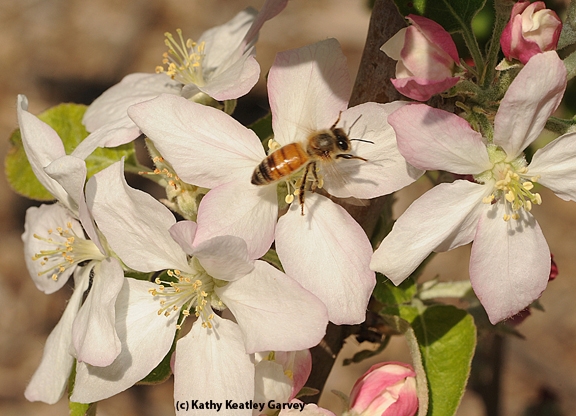
Honey bee pollinating apple blossom. (Photo by Kathy Keatley Garvey)

Gravenstein apples ready to be picked. (Photo by Kathy Keatley Garvey)

Gravenstein apples ready to eat. (Photo by Kathy Keatley Garvey)

